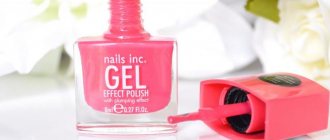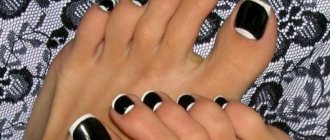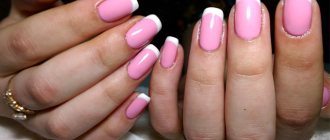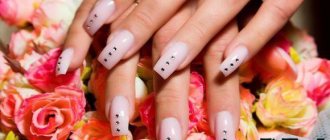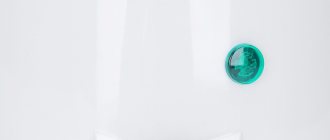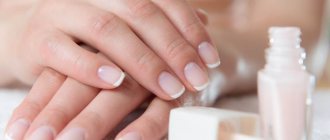Most girls prefer to have long nails. It takes several weeks to grow them. However, the structure of the nail plate is such that they often crack and break. There is a way that allows you to hide the crack that appears; it involves using silk. To do this, you need to know how to use silk to repair nails.
Scheme for strengthening nails with silk
Using a similar technology, nails are strengthened with silk if the plate is particularly thin. Artificial nails will last longer than natural ones. This is due to the difference in thickness. If you are not a supporter of the extension process, then this procedure will come in handy for you.

To do this, you need to follow these simple steps:
- Remove shine using a nail file;
- Align the silk piece with the nail bed and cut out the desired shape;
- Disinfect and degrease the plate;
- Apply a glue strip to the nail and attach the cut fabric;
- Trim the edges with an orange stick;
- After the glue has dried, polish the surface with buff;
- Cover with a layer of varnish.
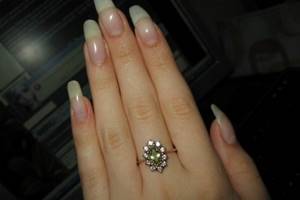
The procedure must be performed several times a month. This will help strengthen and grow nails that will not break or crumble.
How to strengthen your nails with silk
The CNI company has developed a technique for strengthening weak nails. The procedure and necessary materials are shown in the following video.
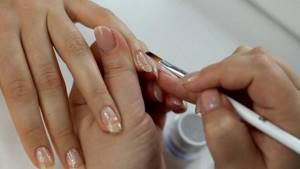
Nail extensions with silk are performed in a similar way. The shown master class allows for lengthening the nails by three millimeters. If you have a manicure lamp and the necessary materials, even a non-professional can lengthen your nails in this way. If the elongation is large, this method will not work. CNI technologists recommend a different technique for this case.
Broken nail
If the nail bursts at the edge, then slightly shortening it is not a problem. But in most cases, cracks appear in the middle or at the base of the overgrown nail. This is not only an unpleasant situation, but also very painful. After all, a woman has to constantly experience discomfort, constantly touching the damaged plate. The pain intensifies, which can lead to the development of an inflammatory process. It is necessary to fix the plate in place of the crack and give it a little time to recover and grow.
In the case of a nail repair, you will have about a week left in stock so that you don’t have to visit the salon and have a well-groomed manicure. If you don’t want to part with long nails, cutting them to the size of the broken one, you can repeat the strengthening. Silk reinforcement can be carried out until it becomes possible to painlessly cut it off at the point of breakage.
Most girls use silk for the most comfortable growing process. Moreover, this is not difficult even at home. You just have to get the hang of it and cut the fabric in a shape that follows the outline of the nail. By maintaining your nails a couple of times a month in this way, you can easily grow even nails that are very prone to brittleness.
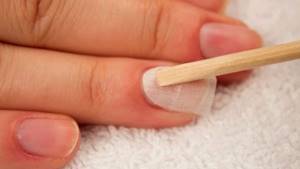
Cons of silk coverings
It's definitely worth noting that silk nail caps are not the most durable manicure option on the market. If you frequently work with your hands or need to wash your hands frequently, the silk can quickly separate from the nail. In these cases, gel may be a better alternative.
Another obvious disadvantage of silk wraps is their inaccessibility. You can buy Silk Nails sets; the price of silk for nails is quite affordable and affordable.
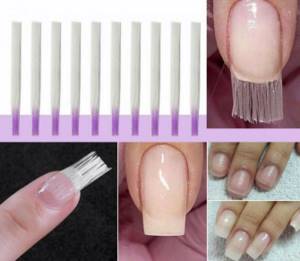
But! In modern salons there are few professionals who know how to carefully apply these coatings. This is due in no small part to the hype and popularity of other manicure techniques such as gel or acrylic. It can be difficult to find a salon that offers this service if you do not live in a large city.
What can replace silk
If there is no way to purchase this material, you can try strengthening the nail with flax or fiberglass. The latter is a durable artificial fabric with moisture-resistant qualities. Available in small skeins with an adhesive base.
It is convenient to temporarily restore the plate with liquid silk. This special product contains microfiber fibers, which form a durable polymer coating that protects the nail from further destruction. The kit intended for repairing the plate contains powder, which is applied directly to the glue. It gives strength while maintaining elasticity.
Sometimes it happens that the material suddenly runs out, then the question arises of how to replace silk for nail repair. An ordinary medical fabric plaster can come to the rescue, but not a rubberized one; the nail must breathe. Tea bag paper is also suitable for these purposes. The principle of repair with all these materials is similar to silk.
Benefits of silk
This material has a lot of advantages. They can be used to repair nails because they:
- lasting;
- perfectly adapts to the shape of the nail plate;
- has a minimum thickness at which traces of repair are not visible.
An additional advantage of silk is that it is visually invisible because it blends with the natural shade of the nail plates. Silk can be purchased separately, or it is also sold in a special set.
Totally agree"?
If fiberglass or fiberglass is used as a basis, then the marigolds will glow effectively in ultraviolet light. For a romantic design, silk fiber is replaced with lace. The advantages of silk extensions are the complete camouflage of cracks on the nails. This procedure is quite suitable for restoring broken nails. Even extremely long nails will not break the plate, as with acrylic extensions.
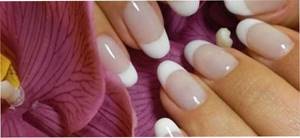
You can choose both linen fibers and silk. Various material structures and colors are available. Any stylish extension designs are available for implementation.
Finished nails do not break or flake. They look natural. Silk extensions will strengthen your nails and smooth out imperfections. By using silk for nails, chewed, injured nails will regain their former splendor, but this is not possible with other methods.
It is good to use silk extensions if the nail fold is overdeveloped or the nail bed is too small. The procedure gives good results for urgent repair of a broken nail. Silk technology has fewer contraindications than acrylic or gel extensions. If your nails are injured or your hands sweat too much, no master will carry out the procedure of gel or acrylic extensions.
But this is not a problem for silk extensions: silk is useful for nails. Natural nails will be able to breathe, as air continues to flow freely to the plate. The silk nail procedure is performed only on tips. Adjustments must be made once a month. Nails grow faster after the first extension, so after the first visit the correction takes place twice a month.
There is no need to file artificial nails. They are removed with a special solvent.
Features of using silk
Many girls have already tried to repair cracks in their nails with varnish, or simply by first covering it with glue.
The problem with this procedure is that after hardening, the varnish or glue becomes brittle, and therefore often cracks in the same places as the nail itself, thereby sometimes even worsening the original situation.
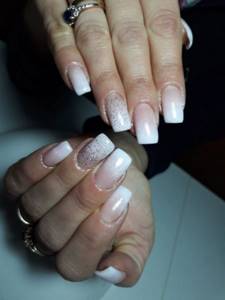
On the other hand, we have a silk ribbon - itself solid, not to mention the fact that the material is quite durable. Here it is needed as a soft spacer between the nail and the next layer.
Usually silk has an adhesive base, and therefore, after fixing it on the nail, it constantly keeps it in the same condition, preventing new cracks and the enlargement of old ones.
Approximately the same situation occurs with the restoration of a lost piece of nail. Silk strengthens the entire nail and prevents further deformation at the site of damage.
As a result, we get a natural contour of the nail, not to mention the fact that the entire nail becomes stronger.
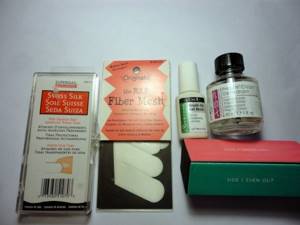
When is silk used?
Now silk for nails is used in cases where it is necessary to repair a nail in the most inconspicuous way. The use of gel or acrylic materials creates undesirable thickness. A nail lengthened in this way stands out from the rest. The purpose of the repair is not achieved.
Another thing is the use of thin durable materials under the general name “silk for nails”: natural silk, linen, fiberglass, fiberglass. Some craftsmen, in the absence of this material, successfully use tea bags made not of paper, but of synthetic fiber.
Indications for use:
- A chipped corner of a nail.
- A crack in the nail located quite high.
- Bitten nails.
- Nail injury (accidental damage with a culinary knife, sawing, etc.).
- Fracture of artificial turf (usually from an impact).
Repair technology
Now you need to learn how to use silk to repair nails. First you need to prepare the broken area of the plate. To do this, use a nail file to make several light movements, starting from the cuticle, and move towards the free edge. Thus, the edges of the fracture are trimmed, and the surface gets rid of shine. After this, degrease with nail polish remover. Then cut off the required amount of fabric to cover the crack. Treat the broken area with glue and attach the cut piece of material. In order for it to lie flat on the nail plate, you need to use an orange stick. After the glue has dried, the excess must be removed. For this procedure, a nail file is used to process the resulting bulge. After treatment, the surface will become smooth. Then you need to cover all your nails with a textured varnish with tiny sandy or shiny particles. This will help hide the unevenness, and the fabric and glue will adhere more firmly to the crack. This place can be hidden with rhinestones or other decorative elements.
It must be borne in mind that you should not repair a nail with silk if the skin is damaged or there is bleeding from the wound.
What is bio-reinforcement of nails?
Broken nail
A broken nail is a real tragedy. The good news is that things can be helped.
Some craftsmen use tea bags, regular glue and other improvised means to repair nails, but a much better solution would be to repair using special glue and spider silk .
Bioreinforcement is the biocorrection of extended, broken, weak nails using fibrion from silkworm spiders.
The bioreinforcement procedure involves gluing natural thick silk for manicure onto the nail plate . The layer of material is completely invisible and does a good job of repairing or strengthening a weak nail plate (for example, after prolonged extension).
Restoring a broken nail
It happens that a crack occurs closer to the middle of the nail plate, and not at the edge. This can not only be uncomfortable, but also cause pain. In this case, removing the nail will be very painful and also unsafe. You need to give the nail time to grow at least a little. To do this, you need to strengthen it and seal it.
Repairing your nails with silk will only take a few minutes. And if you already have some skills in this matter, then the process will speed up much. The result can last for about a week. It will be possible to perform these manipulations again before it becomes possible to trim the nail at the fracture site.
Often ladies use silk fabric to get rid of the fragility of their nails. This is achieved by applying several layers of glue and silk, which makes the plate harder, minimizing its breakage.
Step-by-step recovery process
Now let’s look at the diagram itself on how to repair a nail with silk step by step. It is used to repair it in nail salons, where qualified craftsmen can handle it in a couple of minutes. But you don’t always have the time and money to turn to a professional. In this situation, you can help yourself.
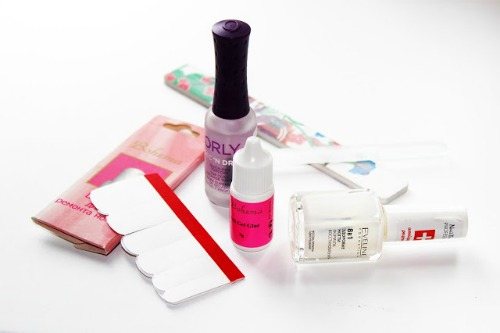
First you need to prepare the tools:
- The main “ingredient” is silk for nails;
- Glue with a special bio-composition. The standard kit usually comes with glue that is not of very good quality, so it would be preferable to buy it separately;
- Don't forget about the anti-adhesive compound. It will come in handy if you suddenly glue your fingers together or apply bioglue incorrectly;
- Manicure scissors;
- Files or buffs of different abrasiveness. 120 and 220 grit are suitable;
- Disinfector is a means for disinfecting and degreasing the surface of nails. It eliminates severe drying, so the nail becomes normal after half an hour.

In addition to silk, linen and fiberglass are also used. The first type of fabric is used in rare cases. This is due to its rough texture, which does not go well with the claw. Fiberglass is slightly more popular than linen, but still inferior to silk fabric.
It is better to purchase the material in rolls with a sticky paper base. To achieve the desired result, the price of the fabric including glue should not be less than 100 rubles. This will allow you to repair your nail with silk more efficiently.
Let's study step by step instructions on how to use silk to repair a broken “claw”:
- It is necessary to prepare the broken part of the plate. To do this, make a few light movements using a cuticle file towards the free edge. This will help smooth out the edges of the crack and get rid of the shine of the surface. Then you need to degrease with a disinfectant;
- Cut the required amount from the fabric roll to cover the resulting crack. It happens that the material suddenly runs out. Therefore, it can be replaced with a regular medical fabric plaster. But it should not be rubberized so that the nail can breathe. Tea bag paper is also suitable, which can be used after shaking out the tea leaves;
- Treat the broken area with a small glue strip and place a cut-out piece of “rag” there to fit the size. Place it flat on the surface using an orange stick;
- When the glue is completely dry, remove any excess. To do this, use a nail file to process the resulting tubercle, making the plate smooth. This will hide damage when applying varnish;
- After repair, cover all the fingers with a textured varnish with shiny or small sand particles. This will help hide all the irregularities and strengthen the adhesion of the fabric and glue to the crack. You can disguise the location of the breakdown with a rhinestone or some other designer item.
You should not repair a nail with silk if the breakage causes damage to the skin or bleeding from the wound. This can only do harm. Therefore, contact a specialist immediately.
Instructions for use
You can fix the breakdown in the salon, where a technician will complete the task in just a couple of minutes. However, it is not always possible to get to the salon. You shouldn’t worry at such moments, because you can repair your nails at home, the main thing is to follow the instructions.

In order to fix a broken nail, we will have to prepare a number of tools:
- Silk;
- Glue (used for repairs);
- Scissors;
- Bang, nail files.

Having prepared all the necessary tools, you can begin to fix the problem. It is best to perform actions in this order:
- It is important, first of all, to treat the broken nail;
- Take the silk and cut the required amount of fabric. You can purchase such material at any specialty store;
- Apply glue to the crack and place a strip of fabric there. Using an orange stick, smooth out the silk. For better grip, these movements should be repeated 2-3 times;
- After the adhesive base has dried, you need to remove the excess layer of glue. To do this, you need to file down the protruding part of the material. This is necessary, first of all, so that the broken part of the nail does not reveal itself in any way when varnished.
A little trick that you can use: after repairing, apply varnish with small sparkles to the nail. In addition, such a varnish will not only hide all the unevenness on the nails, but will also serve as additional grip.
This procedure will last 2-4 days, and if you are careful - up to a week.
Totally agree"?
If fiberglass or fiberglass is used as a basis, then the marigolds will glow effectively in ultraviolet light. For a romantic design, silk fiber is replaced with lace. The advantages of silk extensions are the complete camouflage of cracks on the nails. This procedure is quite suitable for restoring broken nails. Even extremely long nails will not break the plate, as with acrylic extensions.
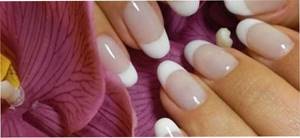
You can choose both linen fibers and silk. Various material structures and colors are available. Any stylish extension designs are available for implementation.
Finished nails do not break or flake. They look natural. Silk extensions will strengthen your nails and smooth out imperfections. By using silk for nails, chewed, injured nails will regain their former splendor, but this is not possible with other methods.
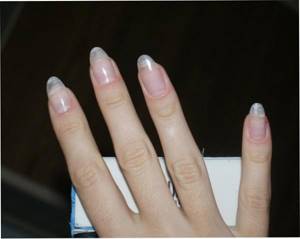
It is good to use silk extensions if the nail fold is overdeveloped or the nail bed is too small. The procedure gives good results for urgent repair of a broken nail. Silk technology has fewer contraindications than acrylic or gel extensions. If your nails are injured or your hands sweat too much, no master will carry out the procedure of gel or acrylic extensions.
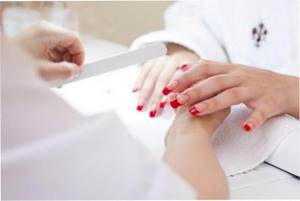
But this is not a problem for silk extensions: silk is useful for nails. Natural nails will be able to breathe, as air continues to flow freely to the plate. The silk nail procedure is performed only on tips. Adjustments must be made once a month. Nails grow faster after the first extension, so after the first visit the correction takes place twice a month.

There is no need to file artificial nails. They are removed with a special solvent.
Acrylic nail extension
This is exactly the technology that was at the origins of the nail industry. All materials for acrylic nails were borrowed from dentistry and subsequently improved.
Acrylic is a special powder used in dentistry. Therefore, initially masters of creating acrylic nails bought materials from dentists. Acrylic, in combination with a special liquid, quickly thickens and hardens in air. Over time, the acrylic industry gained momentum, and special compositions began to appear, used exclusively in the nail business.
Therefore, the statement that acrylic nails are harmful, to put it mildly, is inaccurate... They are no more harmful than others... Acrylic (some cunning masters came up with the name “porcelain”, but it’s the same thing) nails can be extended in two ways: - on forms - special flexible plates, on which the artificial nail is formed; - and on tips (from English tip) - plastic nails that are glued to yours, and material is already applied to them. (I prefer to work on tips). The acrylic nail type is more durable than others. Nails have greater elasticity, elasticity, and do not crack when strongly bent. They are suitable for those women who lead an active lifestyle and the likelihood of nail damage is quite high.
Currently, acrylic nails are extended both on forms - special plates on which the nail is formed, and on tips - artificial glued tips, directly onto which acrylic material is applied.
— One of the main advantages of acrylic technology is that artificial nails created on its basis are considered the most durable today. This property of acrylic nails suits many women, especially those whose working hours are scheduled literally minute by minute, and there is simply not enough time for an additional manicure if one nail around is broken.
— Acrylic nails, in addition to their super strength, have high elasticity and resilience, so they look quite natural, and also do not deform the natural nail as it grows, unlike, say, gel technology. Since when growing, the artificial nail “pulls” the natural one with it, and if the material is not elastic, then the natural nail grows in an irregular shape.
- If an acrylic nail does crack or break, it can be quickly repaired. Acrylic nails are very easy to remove: just hold the tips of your nails in a special solution in which they will simply dissolve. With gel nails, everything is much more complicated, the material does not dissolve in any way, they will have to be cut down, an unpleasant and lengthy procedure that can also cause great harm to the nail plate. Acrylic nails look extremely natural, and they are also thinner than gel nails.
— Acrylic nails protect natural nails from excessive moisture and exposure to adverse environmental factors, and also wean some people from the bad habit of biting nails. Acrylic nails can be given any desired look using decorative varnish and other nail decoration materials.
— The main disadvantage of acrylic nails is that after removing the varnish from an acrylic nail, it loses its original shine (if you use liquid with acetone to remove the varnish), but the situation can be easily corrected even on your own using a polishing file or regular clear varnish.
— Another equally important drawback, which until recently caused great inconvenience to both the master and the client during the procedure, is the pungent odor of acrylic, although it disappears over time (just like after an appointment with the dentist). However, the modern technology of acrylic nail extensions, using a liquid (monomer) odorless or with a muted odor, completely eliminates this disadvantage.
Which nail extension to choose
So how can you tell the difference between a gel, acrylic, and fiberglass nail job? The answer lies in the products used in each process.
Acrylic extensions
Perhaps the most common type of nail extension is acrylic, but it can quickly be replaced by gel.
Acrylic extensions use acrylic, which is applied to the tip of the nail. Acrylic is created by mixing powder and liquid to create a substance that can actually be coated on the tip of the nail, which then hardens.
One way to tell what acrylic nails are doing to you is to see the powder and liquid mixing.
When applying acrylic nail extensions, the master mixes the monomer with dry powder
Don't be fooled when someone tells you that a product is a gel, it is actually acrylic.
This acrylic will air dry to a hard finish and should not be exposed to light. To obtain a good clear finish, acrylic extensions must be sanded because the material remains cloudy before polishing begins.
Acrylic extensions can be removed by soaking the nail in acetone, while UV gel removal requires sanding and acetone is of no use.
Extension gel
Gel extensions, also known as UV gel extensions, differ from acrylic extensions in that no mixing is involved in the creation.
One of the stages of gel nail extensions will be drying the work with a UV lamp.
The gel is already in the jar and should look like hair gel. This substance does not have a strong odor like the acrylic mixture. In addition, the gel is cured with ultraviolet light, so it is often called ultraviolet gel.
Once completed, gel extensions have a more transparent finish and do not require extensive polishing.
Fiberglass for nails
Fiberglass extensions use a mesh or fabric of fiberglass that is placed on the nail and then treated with resin to make the material clear.
After application of the composition, an activator is usually sprayed to cure the resin, resulting in a hard coating.
One of the attractive aspects of fiberglass extensions is that the coating is water-soluble and can be removed simply by applying a certain amount of liquid.
Building up
Quite often in practice you can find silk extensions. This technique allows you to perform a high-quality manicure inexpensively. To do this, a piece of fabric is attached to a real nail using a special composition. A tip is placed on the fabric. After which the nail is leveled.
Tissue extension is an effective method that gives excellent results. This method has many advantages:
- Beautiful and also elastic surface;
- It seems possible to correct minor flaws;
- Materials are used that do not harm the nails.
This method of repair is completely unsuitable in cases where the wound is bleeding. In this case, you risk making things worse.
And most importantly, you should take care of your nails! Only in this case your nails will always be healthy and you won’t need to repair them!
Repairing a natural nail: step-by-step instructions
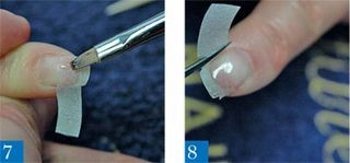
Repair process
Nail repair can be done in a salon or on your own. To carry it out you will need silk, glue, scissors and sanders.
Pay attention to the preparation of the nail plate - do an unedged, trimmed or hardware manicure (depending on your own preferences). The repair process itself is as follows:
The repair process itself is as follows:
- The nail plate is cleaned of varnish and dirt.
- The damaged area is polished using a buff.
- A silk patch of the required size is cut out.
- The fabric is separated from the paper and the sticky side is applied over the crack or secured with glue.
- A thin adhesive layer is applied over the strip.
- After complete drying, the edges of the silk are trimmed with a file, and the surface of the nail can be polished with a buff.
Helpful tips for repairs
- After applying the strip of fabric to the nail, smooth it out using an orange stick - this is optional, but will allow the material to lie correctly;
- the nail will be stronger if you cover the silk with two layers of glue (with a short break in time);
- the patch must be larger than the crack.
When sanding the repaired nail to remove dried glue, be careful not to file away the tissue.
You will get a lot of tips on repairing nails with silk by watching the video tutorial:
https://youtube.com/watch?v=HgnMeyyeUBU
Is it possible to repair artificial nails with silk?
Yes, you can repair gel nails - the procedure will be the same as when repairing natural ones. Before gluing the silk strip, do not forget to remove the varnish coating.
Caring for repaired nails
Repaired nail
The silk repair procedure is easy to perform and effective. Repaired nails do not require special care - it will be enough to cover the surface of the plate with manicure varnish , preferably textured, with grains and glitter (this way the fabric will definitely be invisible).
It is advisable not to use household chemicals without gloves . How long the silk will last on the nail depends only on your caution and accuracy.
To prevent the repaired nail from giving itself away, after the glue has completely dried, treat the plate with sanders.
Durable, reliable, lightweight
Silk for strengthening nails
is a natural and dense material that, after gluing to the nail plate, becomes transparent and invisible. The silk layer is lightweight, durable and smooth. It perfectly strengthens nails and meets all the requirements of a modern woman, although the technique was developed long before the advent of nail extensions.
Silk covering, in addition to strength, also has flexibility, and this is very important so that a woman does not experience discomfort due to too hard pads. Silk strengthens the entire nail plate
Silk strengthens the entire nail plate
, and also secure the free edge of the artificial nail. The silk covering comes in white and pink. It is convenient to use, since after correcting the shape it forms a minimal amount of fibers along the incision line.
Silk for strengthening nails can be produced without an adhesive layer or with an adhesive layer. Self-adhesive fabric is convenient to use because it does not require time to adjust the applied layer, but at the same time, it is less transparent than pure fabric. Many masters in beauty salons work with silk without an adhesive layer precisely because of this shortcoming.
Silk nail coating is preferred by those women and girls who strive for maximum naturalness of manicure and pedicure. In addition, the weight of a reinforced nail is significantly less than that of a gel or acrylic nail. Nails strengthened with silk are easier to correct after they grow out.
Another compelling argument in favor of silk. These are allergic reactions. When using natural material, skin irritation is minimized. This is a very important point for those who have developed allergies due to frequent use of acrylic.
Advantages and disadvantages
Acrylic and its derivatives (gel, shellac) are a modern high-tech material for creating a neat, long-lasting manicure. For many, he has become simply irreplaceable. However, debates about the benefits and harms of its use are still ongoing. There are also masters who prefer to work with gel, while others favor acrylic. Both methods are derivatives of the same technology. Gel extensions are easier to do yourself, but working with acrylic is more complex, multi-stage and requires high professionalism.
Acrylic nail extensions and strengthening have many advantages over other techniques.
- This is a material with high strength. It is able to withstand temperature changes, aggressive environments and mechanical stress. At the same time, it is quite flexible and thin. You can literally fashion a new nail shape out of it if the natural one doesn’t suit you and needs correction.
- To work with acrylic, you do not need a manicure lamp for drying. This significantly reduces operating time and equipment costs. The material itself hardens in air quite quickly.
- The material is non-toxic and safe for humans. And 60 years ago it was the main material for dental prosthetics.
- It is easy to remove the acrylic coating using a special product. You can also use regular nail polish remover. No sawing required. Therefore, the integrity of the nail plate is not compromised, there is no need to breathe acrylic dust, and time for correction or removal of manicure is significantly saved.
- The special texture allows you to fill microcracks and unevenness on the nail. Thanks to this, the surface is perfectly leveled, and destruction does not proceed further. Nails become overgrown under the coating.
- Acrylic is ideal for painting, creating fashionable volumetric and matte designs. It gives wide scope for the creativity of nail art masters.
- When damaged or overgrown, acrylic nails can be easily corrected. And the procedure itself is much cheaper than when working with other materials.
- The coating creates the natural effect of well-groomed natural nails and can last an average of three weeks. You can do it yourself at home.
Acrylic is used widely in various areas of the economy, in everyday life and in technology. It is not harmful and has even been used in dentistry. Therefore, we can only talk about harm conditionally. An unpleasant factor is the pungent odor of the material during operation. But this cannot harm the body, it only causes uncomfortable sensations. There are contraindications to acrylic extensions. They do not affect health, but the quality of work itself, due to some factors, may not be as desired.
You should not get nail extensions while pregnant or breastfeeding. Taking certain antibiotics or chemotherapy may also be incompatible with this manicure procedure.
It is very rare to experience an allergy to acrylic or its volatile components during the work process. Masters have every right to refuse to do a manicure if you have skin diseases, herpetic rashes, or signs of fungus on your hands - for your own good. If there is damage to the nail plate or injuries near the nail, it is also worth thinking about the advisability of acrylic coating. In general, acrylic will not harm healthy nails. And the nail plates will look well-groomed and more protected.
Broken nail
Sometimes a crack in the nail does not occur on the free edge, but in the middle or closer to the base of the regrown nail. Such an unpleasant moment not only causes discomfort, but is also accompanied by pain when touched. And even in this case, it is better not to cut off the affected nail, because It will be very painful. Here it would be more advisable to seal the crack so that the nail grows a little. Using silk for this, you can be sure that the repair will not take even 5 minutes, and the result will last up to a week.
Most ladies use silk to make the growing process as comfortable as possible. Strengthening nails with silk is carried out in the same way as repairing, however, you need to cut a piece of fabric so that it follows the shape of the nail. By doing this simple procedure 1-2 times a month, you can grow strong and healthy nails, even though they are prone to brittleness or crumbling.
What it is
First, we should look at the photo of silk for nails to understand what it is.
Silk is a soft fabric made from natural materials - it is made from silkworm fibers, which are processed into threads, which subsequently become the basis for silk fabric.
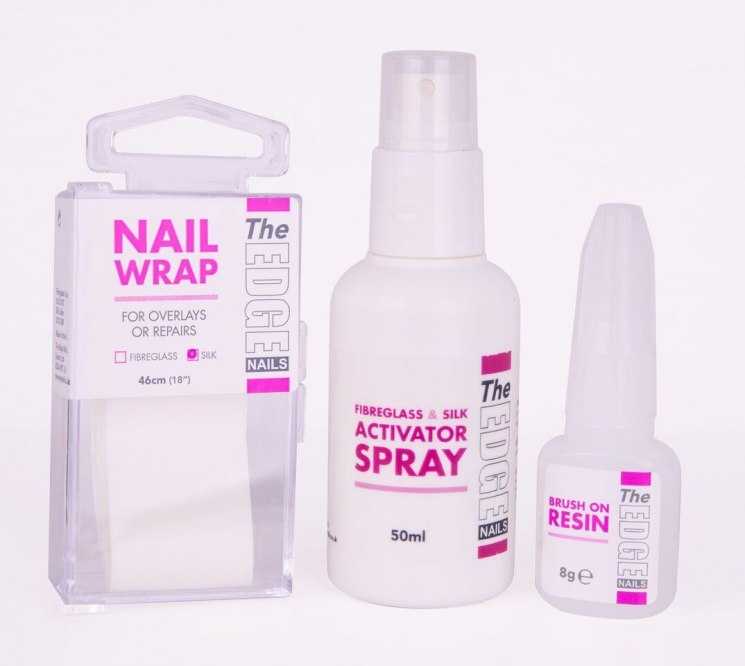
Due to the fact that natural materials are used as a base, silk is very thin, but at the same time very durable.
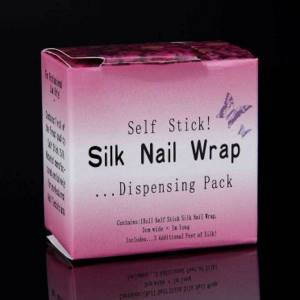
All this was the reason why silk is used in working with nails - repairing or adjusting them, and therefore I would like to talk further about the conditions under which silk should be used for nails.
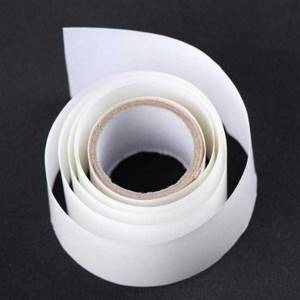
Combination with other procedures
The use of silk can be combined with other procedures, such as strengthening nails with biogel or design with gel polish. The sequence of each procedure will be unique, but the main rule remains unchanged: the silk is placed on a clean, grease-free plate without first applying any basic products.
Classic manicure
A classic manicure is a simple nail polish and design. It does not involve activator liquids or the use of UV lamps. Silk fits into this procedure as follows:
- First, a medical manicure is done. The nail plate is leveled and the cuticle is removed.
- Then a silk patch or reinforcement with silk cloth is made.
- The fabric is polished with a buff until the nail plate is leveled.
- Base varnish is applied. This can be a means to level the nail plate.
- Then the design is done. Plain coating, patterns or the use of decorative elements.
- A fixative or a simple colorless varnish is applied on top.
Silk can slightly extend the life of a classic manicure. But for the most part, the lifespan of polish depends on lifestyle and the quality of materials.

Gel polish
If you're a fan of gel polish, silk enhancement is still available to you. In this procedure, the order remains virtually unchanged:
- First, the usual nail treatment is performed. The cuticle is removed, the shape of the nail plate is created and the free edge is formed.
- Then a silk patch or strengthening of the entire plate is made.
- After smoothing the nail texture, apply a base product on top. Additional degreasing is not required, because it was carried out before using silk.
Then the procedure is completed in the usual way with drying in a lamp and the sequential creation of layers of products.
Manicurists claim that the silk coating increases the wear time of gel polish several times. You can check whether this is true or not at your next visit to the manicurist. In any case, this possibility cannot be completely ruled out. Even after careful polishing, silk retains its texture. It probably provides better adhesion between the nail and the base product.
Strengthening with biogel
Strengthening with biogel in combination with silk gives excellent results. Designs made on this basis last much longer. Biogel and silk can be combined with the application of gel polish to make the manicure extremely durable. The procedure is very simple:
- Remove the cuticle and shape the free edge of the nail
- Degrease the nail plate.
- Apply silk and soak it with special glue.
- After the glue has dried, polish the nail plate to even out its texture.
- Apply the first layer of biogel and dry it.
- At this point, you can immediately apply the colored gel polish. When using biogel, a base is no longer required. Dry the color layer.
- Apply sealer and dry your nails again.
As you can see, anyone can repeat the procedure. You just need to purchase the necessary tools and practice a little.

Broken nails
The appearance of cracks is caused by the abuse of shellac and extension procedures, as well as poor nutrition. Weak plates begin to break, and this ruins the manicure. Sometimes the nail cracks closer to the base or in the middle, which is accompanied by discomfort, and pain appears when touched. There is no need to cut it off; it is best to seal the affected area. Here you can use adhesive-based silk to repair nails. It will help temporarily strengthen or repair the surface. The silk that covers the nail plate creates a protective layer that prevents it from deteriorating further.
You may be interested in: Gel polish “Formula Pro”: reviews, varieties, nuances
The work will take very little time, and the result will last about 7 days. This is done until the nail can be cut without pain. Silk is used to make it easier to grow nails. To strengthen them, cut off a piece of fabric that follows the shape of the nail plate. If you perform this procedure every month, or maybe twice, then even brittle and crumbling nails will grow healthy and strong.
Reviews of manicure silk
Before you learn how to use silk to repair nails, it is advisable to read what those who have already used this material say. You can purchase this product online or in cosmetic departments of stores. Repairing nails with silk under gel polish can be done on both natural and artificial plates. In the case of artificial nails, the cracked one should be sealed with silk, and on the rest, just update the design. Silk for nail repair, reviews of which are mostly positive, is a temporary aid for brittle plates. This great thing will help maintain length and save your nails from painful cutting. It is, of course, recommended to visit a cosmetologist who knows all the nuances and features of the manipulation. If necessary, he will tell you all the details of the procedure and tell you how to preserve your nail.

It is necessary to remember that you must take care of your hands, this largely applies to your nails. If even taking vitamins does not help keep them healthy, you should resort to special creams and baths that are aimed at strengthening the nail plate.
Source
When a nail breaks
There are cases when the nail breaks off along the smile line, its end is damaged, or the corner of the free edge is chipped. There is no need to resort to reinforcement with silk. Much more dangerous for nails are small cracks in the corners, which are formed because the nail cannot maintain its length: it bends due to certain movements. At first, this does not lead to a crack, but after several such bends it can straighten out, the keratin fibers in its thickness break and the moment comes when the nail itself cracks and then breaks.

This usually occurs in the lower third of the nail bed near the lateral folds. The crack is painful, and it is not possible to simply cut the length down to it. This is the classic case for using silk. A small piece of material is cut with special small scissors to the size of the nail plate and carefully adjusted to its size.
Using one of the means for fixing silk on the nail, fix it and leave it until the crack or tear completely heals. This “patch” can be coated with varnish, gel polish or any other material, including for extensions.
Advice from professionals
To significantly lengthen the nail, they use not only silk for nails, but also special gels. Not everyone can perform this procedure at home: you will need to purchase special professional gels and have the skill of setting the mold.
Description of the procedure:
- Perform standard preparation of nails for application of artificial coating.
- Cut silk along the nail.
- Bondex is applied to the nail.
- A base gel is applied to the nail and the cut silk is embedded in it, after which it is dried in UV.
- Lay out the nail bed with pink gel extension and dry it in UV.
- Submit the form.
- Smile gel is applied to the free edge and dried in UV.
- Reinforcement is performed with stretch gel and dried in UV.
- Model the nail with a transparent gel and dry it in UV.
- Remove the dispersion, file and polish the nail.
- Cover with top gel, dry in UV, remove the dispersion.
To ensure that a thin layer of glue sticks well, use designs: glitter, rhinestones, various sparkles. If there is a wound on the nail, do not use glue, it will cause irritation. Sometimes a “patch” can be made by gluing two pieces of silk “crosswise”.

